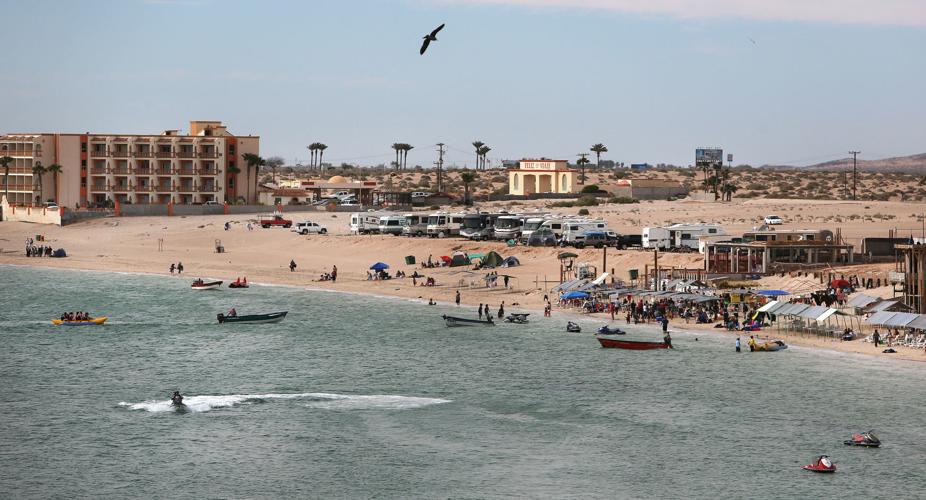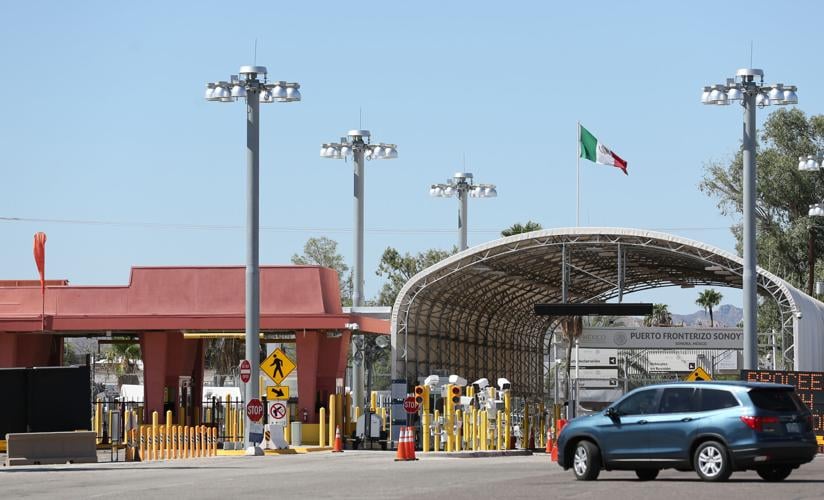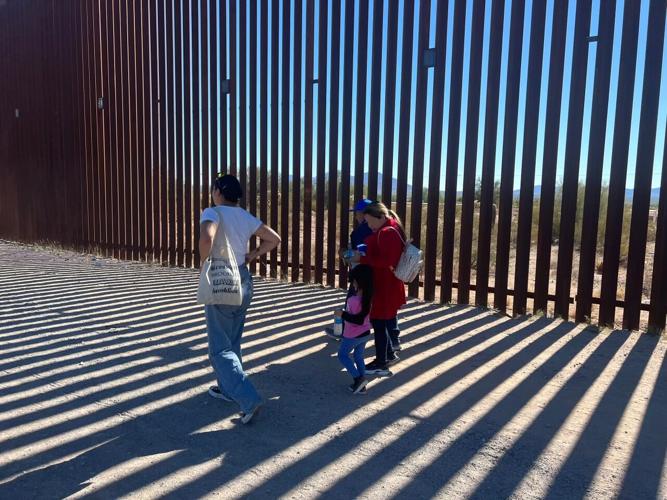Travelers returning from “Arizona’s beach” in Sonora are likely to face longer wait times at the border, after U.S. Customs and Border Protection announced reduced vehicle processing capacity at the Lukeville port of entry, beginning Monday.
Port-of-entry staff have been temporarily reassigned to assist border agents with taking migrants into custody and processing them, amid an ongoing surge in migrant arrivals in the Tucson sector.

The Lukeville-Sonoyta port of entry on Arizon’s border with Mexico.
“The U.S. is continuing to see increased levels of migrant encounters at the Southwest Border, fueled by smugglers peddling disinformation to prey on vulnerable individuals and encourage migration,” a Monday CBP statement said. “As we respond with additional resources and apply consequences for unlawful entry, the migration trends shift as well.”
In September, field office agents were also reassigned from the Nogales ports of entry to help with processing migrants, leading to longer average wait times. Another border crossing in Eagle Pass, Texas was closed to vehicle entry on Monday.
Jannette Aguayo, of Casa Grande, said she and her family sat through a three-hour wait at the Lukeville crossing on Monday afternoon, as they returned from a Thanksgiving weekend trip to Puerto Peñasco, known in the U.S. as Rocky Point or Arizona’s beach.
Aguayo, who works remotely, owns a second home in Rocky Point and travels there whenever her 10-year-old son has time off from school, she said Tuesday.
The family had decided to delay their return to Arizona until Monday, to avoid Sunday’s holiday weekend traffic. Expecting a five-minute wait at the border, Aguayo was shocked at the long line of vehicles she encountered.
Learning about CBP’s staffing changes made her worry for the future, she said.
“If, in case of emergency, I cannot come back to my regular work activities in the U.S., or my son’s education in the U.S., that’s going to be a problem,” she said. “What’s going to happen to the investment I made, and many have made, in Rocky Point?”
She said if she didn’t already own a home there, she might reconsider visiting if the return trip was too difficult.
“If I were a person who’s going to go to Rocky Point for the weekend, and I see I’m going to be facing these issues at the border coming back, I’m sorry, I’d drive two more hours and go to California,” she said.

Puerto Peñasco, otherwise known as Rocky Point or "Arizona's beach." Travelers returning from the Sonora coast are likely to face longer wait times at the border, after U.S. Customs and Border Protection announced reduced vehicle processing capacity at the Lukeville port of entry.
Puerto Peñasco’s tourism secretary, Martín Martínez, said he understands the need for CBP’s decision but is worried about the impact on tourism.
“We are concerned, of course,” he said Tuesday. But tourism officials are hopeful that long delays will only happen occasionally, and that the addition of a new priority “Sentri” lane at the Lukeville crossing will help ease the pressure.
The Sentri lane, for Sentri-pass holders, is under construction now and expected to be operational by January, Martínez said.
Arizona tourism, and real estate investment, is crucial to Puerto Peñasco’s economy, he said.
“I would say 80 percent of our tourism comes from Arizona,” he said. “Our job is to make sure they come to Peñasco, they have a good time and return safely, because we want them to come back.”
Business community optimistic
The business community in Rocky Point is optimistic that changes at the border will have minimal impact, said Keith Allen, sales director for the tourist destination’s Encántame Resort. Allen lives in Rocky Point full-time, but travels to Tucson and Phoenix monthly.
When Allen heard about CBP’s reassignments, “obviously, I was a little disappointed, but I understand why they’re doing it,” he said Tuesday. “They’ve got their hands full.”
But Allen isn’t too worried. Congestion was common at the Lukeville border crossing even before the staffing changes, and many Rocky Point visitors are experienced in avoiding peak border-crossing hours, said Allen, a member of the Peñasco Business Coalition.
“Most of our savvy travelers know the border opens at 6 a.m., and they’re in the car at 4:30 or 5, and they have no wait,” he said. Other visitors spend the day on the beach and head back to Arizona in the evening to avoid peak hours, he said.
“We have so many people that love Rocky Point and they come down here as often as they can. They will adjust accordingly,” he said. “It’s a little hiccup, and I’m hoping it’s just for a few months. Hopefully our U.S. government will give them the budget to add more agents.”
Short-term fix
Migrant-aid workers in the region say this temporary fix doesn’t address a longstanding reality facing the border enforcement agency: the need to hire more agents, and medical personnel, to receive and process the massive number of migrant arrivals.
Under-staffing not only strains the agents; it means migrants who intend to surrender and request asylum are waiting in harsh conditions for hours, or even days, before border agents reach them, said Laurie Cantillo, water-truck driver and board member for nonprofit Humane Borders. The humanitarian-aid group has an office in Ajo, about 38 miles north of Lukeville.
“Many of these people are not equipped to be even for a few hours, let alone overnight or longer, in the middle of this harsh desert environment,” Cantillo said. “They may be told by their coyotes (human smugglers), ‘Oh yeah, you cross the border and in 30 minutes, they’ll pick you up.’ It’s anything but that. They may be miles away from a safe environment where they can be processed for asylum.”

A family seeks to surrender to border agents on Nov. 12, after crossing into the U.S. near Lukeville, Arizona, in Organ Pipe Cactus National Monument.
Aid workers often see a couple hundred asylum seekers per day entering Arizona near Lukeville, which is located within Organ Pipe Cactus National Monument. The asylum seekers arrive from all over the world, including Guatemala, Ecuador, Mauritania, India and Colombia.
But on some recent busy days, as many as 1,000 people have entered there, Cantillo said.
On Monday, Humane Borders volunteers saw a mother and her child being medically evacuated from the Lukeville area, she said. About 700 migrants arrived there that day, she said.
The Tucson sector has been the busiest of the nine southern border sectors since July. In October, border agents encountered 55,000 migrants between official ports of entry in the Tucson sector, up from 51,000 the month prior, even as the number of migrant encounters border-wide fell in October.
The border wall at Lukeville is littered with a patchwork of welding repairs, showing how often, and how easily, migrants or human smugglers have been able to cut through the steel bollards to enter Arizona, Cantillo said.
Humane Borders has a good relationship with CBP officers in the region, she said, helping them locate migrants awaiting processing, and providing basic first aid side by side with Border Patrol’s search-and-rescue teams.
“We’ve been pressuring CBP to do a better job of staffing,” she said. “Everyone who is there is doing the best they can. But they have been vastly understaffed to handle the situation.”






